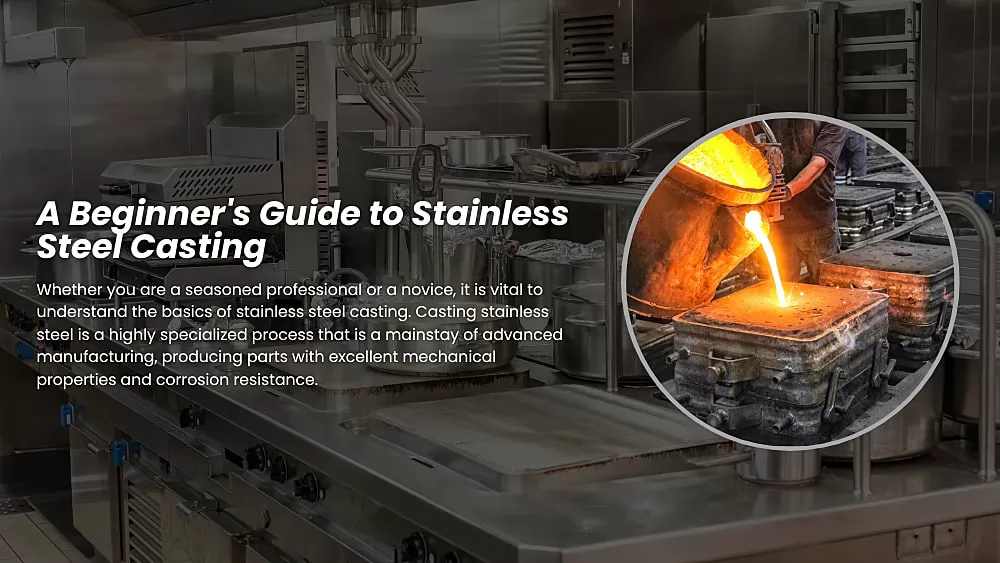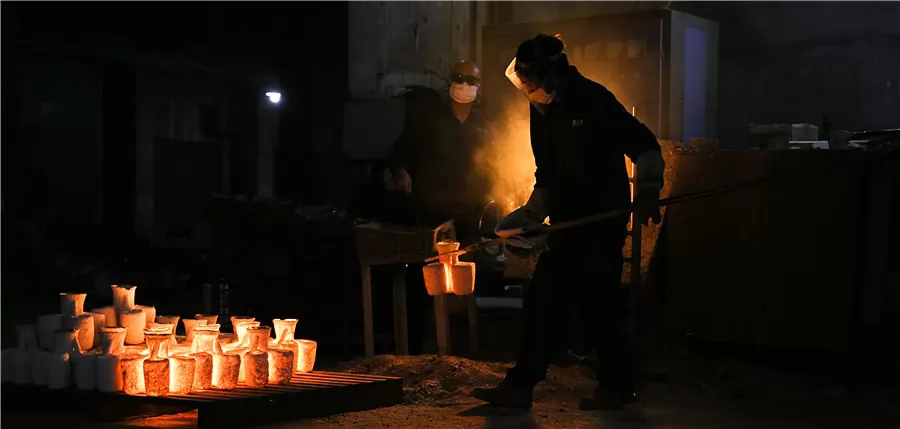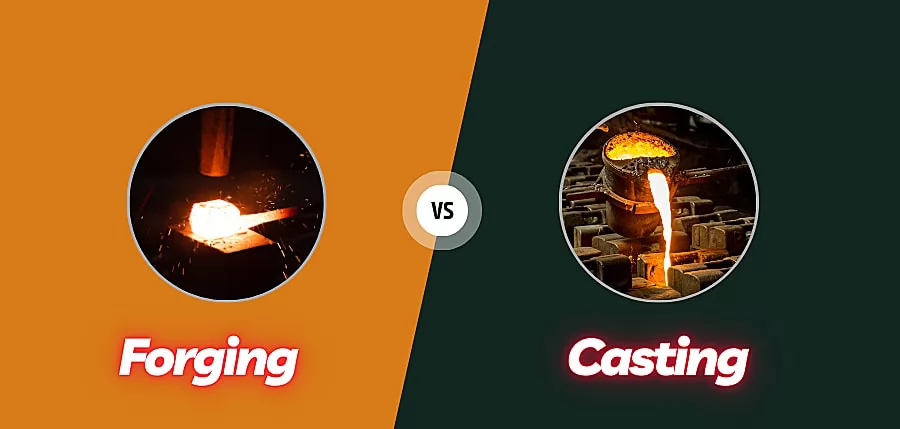
Whether you are a seasoned professional or a novice, it is vital to understand the basics of stainless steel casting. Casting stainless steel is a highly specialized process that is a mainstay of advanced manufacturing, producing parts with excellent mechanical properties and corrosion resistance. Through the investment casting process, stainless steel in a molten state is carefully poured into precision molds to form complex geometries and designs. This guide will simplify the process, providing you with the basic knowledge and insights you need to successfully navigate the world of stainless steel casting.
- What are stainless steel castings?
- What are the steps to casting stainless steel castings?
- Why use stainless steel to make castings?
- What are the types of stainless steel used in casting?
- The best grades of stainless steel for casting
- What are the common stainless steel castings?
- Controlling stainless steel defects during casting
- Stainless steel casting standards and quality control
- Factors affecting the cost of stainless steel castings
- Stainless steel forging vs. stainless steel casting
- FAQs about Stainless Steel Castings
- Stainless steel casting project with Besser Foundry
What are stainless steel castings?
Stainless steel castings are metal parts produced by pouring molten stainless steel into molds. The casting process allows for the creation of complex shapes and detailed designs that are essential in many industries. Stainless steel is an excellent material for castings due to its strength, durability, and corrosion resistance. These attributes make stainless steel castings suitable for a wide range of applications, from industrial components to consumer products.
What are the steps to casting stainless steel castings?

The process of casting stainless steel castings involves several key steps:
① Pattern Creation
The first step is to create a pattern or model of the desired part. This pattern is typically made from wax, plastic, or wood and is used to form the mold cavity.
② Mold Making
Next, a mold is created around the pattern. Molds can be made from various materials, including sand, plaster, or ceramic. The mold must be able to withstand the high temperatures of molten metal, such as stainless steel.
③ Melting and Pouring
Stainless steel is melted in a furnace until it reaches the required temperature. The molten metal is then poured into the mold cavity, filling it completely.
④ Cooling and Solidification
Once the mold is filled, the stainless steel is allowed to cool and solidify. This cooling process must be controlled to prevent defects such as cracks or warping.
⑤ Mold Removal
After the stainless steel casting has solidified, the mold is removed. Depending on the mold material, this can involve breaking the mold away from the casting or using other methods to extract the casting.
⑥ Finishing
The final step involves finishing the stainless steel casting. This can include processes such as machining, grinding, and polishing to achieve the desired surface finish and dimensions.
Why use stainless steel to make castings?
The main benefits of using stainless steel are as follows:
| Reason | Description |
|---|---|
| Corrosion Resistance | Excellent resistance to moisture and chemicals. |
| Strength and Durability | High tensile strength and durability under heavy loads. |
| Heat Resistance | Retains strength at high temperatures. |
| Aesthetic Appeal | Clean, polished appearance. |
| Hygienic Properties | Easy to clean and maintain. |
| Versatility | Can be alloyed for enhanced properties. |
| Recyclability | Highly recyclable without losing properties. |
What are the types of stainless steel used in casting?
Several types of stainless steel are commonly used in casting, each offering unique properties:
| Type of Stainless Steel | Description | Common Grades |
|---|---|---|
| Austenitic Stainless Steels | Known for excellent corrosion resistance, high toughness, and ease of fabrication. | 304, 316, 321 |
| Martensitic Stainless Steels | High strength and hardness, used where wear resistance is crucial and corrosion resistance is less critical. | 410, 420, 440 |
| Ferritic Stainless Steels | Good corrosion resistance, magnetic, used where moderate corrosion resistance is sufficient but higher mechanical properties are needed. | 430, 409, 446 |
| Duplex Stainless Steels | Mixed microstructure of austenite and ferrite, offering high strength and good corrosion resistance, used in demanding environments. | 2205 (Duplex), 2507 (Super Duplex) |
| Precipitation Hardening (PH) Stainless Steels | Heat treatable, high strength, good corrosion resistance, used in applications requiring strength and corrosion resistance under high temperatures. | 17-4 PH, 15-5 PH |
The best grades of stainless steel for casting
Some of the best grades of stainless steel for casting include:
-
304 Stainless Steel: Known for its excellent corrosion resistance in a wide range of atmospheric environments and many corrosive media. It is commonly used in food processing equipment, kitchen equipment, and architectural applications.
-
316 Stainless Steel: Offers superior corrosion resistance compared to 304, particularly against chlorides and other industrial solvents. It is widely used in marine environments, chemical processing, and pharmaceutical equipment.
-
317 Stainless Steel: Provides enhanced corrosion resistance in acidic environments due to its higher molybdenum content compared to 316. It is used in pulp and paper processing, chemical processing, and pharmaceutical industries.
-
Duplex Stainless Steels (e.g., 2205 and 2507): Offer a combination of high strength and excellent corrosion resistance, making them suitable for applications where both properties are critical, such as offshore oil and gas platforms, marine environments, and chemical processing.
-
17-4 PH Stainless Steel: A precipitation-hardening stainless steel that combines high strength with good corrosion resistance. It is used in applications requiring high strength and toughness, such as aerospace components and medical devices.
What are the common stainless steel castings?
Stainless steel castings are used in a wide range of industries and applications. Here are some common examples:
-
Valves and Pump Components: Stainless steel is commonly used for casting valve bodies, valve handles, valve stems, pump housings, impellers, and other critical components in fluid handling systems.
-
Food Processing Equipment: Stainless steel castings are prevalent in the food industry for components such as mixing paddles, conveyor parts, cutting blades, and processing equipment due to their hygienic properties and resistance to corrosion.
-
Marine Hardware: Cast stainless steel is used extensively in marine environments for fittings, cleats, hinges, and other hardware due to its resistance to saltwater corrosion and durability.
-
Architectural and Decorative Elements: Stainless steel castings are utilized for architectural elements like handrails, door handles, decorative sculptures, and building facades due to their aesthetic appeal and resistance to weathering.
-
Medical Equipment: Components for medical devices and equipment, such as surgical instruments, orthopedic implants, and medical tooling, often utilize stainless steel castings for their biocompatibility, corrosion resistance, and sterilization capabilities.
-
Automotive and Aerospace Components: Stainless steel castings are used in automotive and aerospace applications for parts like exhaust manifolds, turbine blades, brackets, and structural components due to their strength, heat resistance, and corrosion resistance.
-
Industrial Machinery: Various industrial machinery components, including gears, housings, bearings, and machine tooling, benefit from stainless steel castings due to their durability, wear resistance, and ability to withstand harsh operating conditions.
Controlling stainless steel defects during casting
Defects in stainless steel castings can compromise the quality and performance of the final product. Here are some common defects and ways to control them:
Porosity
Porosity refers to the presence of small holes or voids in the casting. This can be caused by trapped gases or shrinkage during cooling. To control porosity, ensure proper degassing of the molten metal and use controlled cooling rates. Vacuum casting or adding deoxidizers can also help reduce porosity.
Cracks
Cracks can occur due to thermal stresses during cooling or improper handling of the casting. To prevent cracks, maintain uniform cooling rates and avoid sudden temperature changes. Using suitable mold materials and proper mold design can also help minimize the risk of cracking.
Inclusions
Inclusions are foreign materials or impurities that get trapped in the casting. These can weaken the material and cause defects. To control inclusions, use clean raw materials and ensure proper melting and pouring techniques. Filtering the molten metal before casting can also help remove impurities.
Warping and Distortion
Warping or distortion occurs when the casting does not maintain its intended shape. This can be caused by uneven cooling or improper mold design. To control warping, ensure uniform cooling and use molds that provide adequate support to the casting. Post-casting heat treatments can also help relieve internal stresses.
Surface Defects
Surface defects such as roughness, scaling, or pitting can affect the appearance and performance of the casting. These can be caused by issues with the mold surface or improper pouring techniques. To control surface defects, ensure smooth mold surfaces and use appropriate pouring methods. Surface treatments such as polishing or coating can also improve the final finish.
Stainless steel casting standards and quality control
Ensuring the quality of stainless steel castings involves adhering to industry standards and implementing rigorous quality control measures. Here are some key aspects:
Key Standards
- ASTM: Ensures material properties and quality.
- ISO: Provides guidelines for dimensional tolerances.
- EN: Covers general purpose castings.
Quality Control Measures
- Material Inspection: Verify chemical composition and mechanical properties.
- Mold and Casting Process: Check pattern accuracy and maintain precise temperatures.
- Non-Destructive Testing (NDT): Use visual, ultrasonic, radiographic, and dye penetrant inspections to detect defects.
- Mechanical Testing: Measure tensile strength, hardness, and impact resistance.
- Dimensional Inspection: Ensure precise dimensions with tools like Coordinate Measuring Machines (CMM).
Factors affecting the cost of stainless steel castings
Several factors influence the cost of producing stainless steel castings. Understanding these can help you manage expenses and make informed decisions.
1. Material Costs
- Grade of Stainless Steel: Higher-grade alloys cost more due to their enhanced properties.
- Raw Material Prices: Fluctuations in the market prices of raw materials impact overall costs.
2. Complexity of Design
- Intricacy of Patterns: More complex designs require more detailed patterns, increasing production costs.
- Dimensional Tolerances: Tighter tolerances demand more precision and higher quality control, raising expenses.
3. Size and Weight
- Larger Castings: Bigger parts require more material and energy, driving up costs.
- Weight: Heavier castings incur higher material and shipping costs.
4. Production Volume
- Batch Size: Small batches typically cost more per unit due to less efficient use of equipment and resources.
- Economies of Scale: Larger production runs can reduce the cost per unit.
5. Labor and Overhead
- Skilled Labor: Higher wages for skilled workers increase production costs.
- Operational Costs: Energy, maintenance, and facility expenses contribute to overhead costs.
6. Machining and Finishing
- Post-Casting Processes: Additional machining, polishing, or coating adds to the overall cost.
- Surface Finish Requirements: Higher quality finishes require more time and resources.
7. Quality Control and Testing
- Inspection Processes: Rigorous quality control measures and testing (e.g., NDT, mechanical testing) add to the cost.
- Compliance with Standards: Meeting specific industry standards can increase costs due to stricter quality requirements.
8. Tooling and Equipment
- Initial Tooling Costs: Creating molds and patterns involves upfront costs.
- Equipment Maintenance: Regular maintenance and upgrades of casting equipment are necessary and contribute to expenses.
9. Lead Time and Delivery
- Production Time: Shorter lead times may require expedited processes, increasing costs.
- Shipping and Logistics: Transportation and logistics expenses add to the final cost.
By considering these factors, you can better understand the cost structure of stainless steel castings and identify areas where you might optimize to reduce expenses.
Stainless steel forging vs. stainless steel casting

Stainless steel forging and stainless steel casting are two different manufacturing processes with distinct advantages and applications.
Manufacturing Process
Forging involves shaping the **stainless steel** by applying compressive forces using hammers or presses. This process improves the material's strength and grain structure. Casting, on the other hand, involves pouring molten **stainless steel** into molds to create the desired shape.
Strength and Durability
Forging generally produces parts with higher strength and durability due to the improved grain structure and reduced porosity. Castings can have slightly lower strength but offer excellent corrosion resistance and the ability to create complex shapes.
Design Flexibility
Casting provides greater design flexibility, allowing for intricate shapes and detailed features. Forging is limited to simpler shapes and may require additional machining to achieve complex designs.
Cost
The cost of forging and casting can vary based on the complexity of the design and the required material properties. Forging can be more expensive due to the tooling and labor involved, but it is more efficient for producing high-strength parts in smaller quantities.
Applications
Forging is commonly used for parts that require high strength and impact resistance, such as gears, crankshafts, and connecting rods. Casting is ideal for producing complex parts with detailed features, such as pump housings, valve bodies, and turbine blades.
FAQs about Stainless Steel Castings
1. What are stainless steel castings?
Stainless steel castings are products created by pouring molten stainless steel into a mold to form specific shapes. They are known for their durability, corrosion resistance, and high strength, making them suitable for a wide range of applications.
2. What industries use stainless steel castings?
Stainless steel castings are used in numerous industries, including automotive, aerospace, construction, food processing, medical, and marine, due to their versatility and robustness.
3. What are the benefits of using stainless steel castings?
The primary benefits include excellent corrosion resistance, high strength-to-weight ratio, durability, and the ability to produce complex shapes with precise dimensions. They also have good aesthetic appeal and hygiene properties, especially important in food and medical applications.
4. How are stainless steel castings made?
The process involves creating a mold, melting the stainless steel, pouring the molten metal into the mold, allowing it to cool and solidify, and then removing the mold. Post-casting processes like machining and finishing may also be applied.
5. What types of stainless steel are commonly used in castings?
Common grades include 304 and 316 stainless steel, known for their corrosion resistance and mechanical properties. Other grades may be used depending on specific application requirements.
6. How do I choose the right stainless steel casting for my application?
Consider factors such as the operating environment (e.g., exposure to corrosive substances), mechanical requirements (e.g., strength and durability), and any specific industry standards or certifications needed for your application.
7. Are stainless steel castings customizable?
Yes, stainless steel castings can be highly customized to meet specific design and functional requirements. This includes adjustments in shape, size, and material composition to suit various applications.
Stainless steel casting project with Besser Foundry
As a first-class stainless steel casting supplier, we can provide you with precision metal casting and machining services. We use a specialized investment casting process to customize high-quality stainless steel castings for your project. If you need more information about the services and capabilities of our investment casting company, please contact us today!



